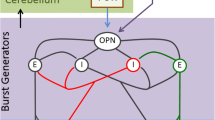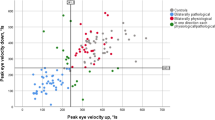Abstract
Extensive oculomotor testing and quantitative MRI evaluation was performed in seven patients with idiopathic cerebellar ataxia without extracerebellar symptoms (IDCA-C) and in ten patients with additional extracerebellar symptoms (IDCA-P). The most severe oculomotor deficits were disturbed smooth pursuit, optokinetic nystagmus and suppression of the vestibulo-ocular reflex (VOR). The symptoms correlated well and consistently with the amount of atrophy of the flocculus and the dorsal vermis. These correlations, however, were not specific, and deficits also correlated with the amount of atrophy of other cerebellar structures. No correlation was found between saccade velocity and brain-stem atrophy or between saccade metrics and atrophy of the dorsal vermis. Although patients with IDCA-P had more severe oculomotor deficits than patients with IDCA-C, the pattern of the oculomotor disturbances was the same for both groups. Thus, eye movement analysis alone is not sufficient to distinguish between patients with pure cerebellar ataxia and those with additional extracerebellar symptoms.
Similar content being viewed by others
References
Allen JH, Martin JT, Mclain LW (1979) Computed tomography in cerebellar atrophic processes. Neuroradiology 130:379–382
Aoyagi M, Sano R, Kimura Y, Nakamura T, Watanabe J, Harada (1989) Comparative study on computed tomography and neurootological findings in spinocerebellar degeneration. Acta Otolaryngol Suppl 468:407–410
Avanzini G, Girotti F, Crenna P, Negri S (1979) Alterations of ocular motility in cerebellar pathology — an electrooculographic study. Arch Neurol 36:274–280
Baloh RW, Konrad HR, Honrubia V (1975) Vestibulo-ocular function in patients with cerebellar atrophy. Neurology 25:160–168
Baloh RW, Konrad HR, Dirks D, Honrubia V (1976) Cerebellar-pontine angle tumors — results of quantitative vestibulo-ocular testing. Arch Neurol 33:507–512
Baloh RW, Jenkins HA, Honrubia V, Yee RD, Lau CGY (1979) Visual-vestibular interaction and cerebellar atrophy. Neurology 29:116–119
Baloh RW, Beykirch BS, Tauchi BS, Yee RD, Honrubia V (1988) Ultralow vestibular reflex time constant. Ann Neurol 23:32–37
Cogan DG, Chu FC, Reingold DB (1982) Ocular signs of cerebellar disease. Arch Ophthalmol 100:755–760
Dichgans J (1984) Clinical symptoms of cerebellar dysfunction and their topodiagnostical significance. Hum Neurobiol 2:269–279
Dichgans J, Jung R (1975) Oculomotor abnormalities due to cerebellar lesions. In: Lennerstrand G, Bach-y-Rita P (eds) Basic mechanisms of ocular motility and their clinical implications. Pergamon Press, Oxford, pp 281–298
Dichgans J, Von Reutern GM, Römmelt U (1978) Impaired suppression of vestibular nystagmus by fixation in cerebellar and noncerebellar patients. Arch Psychiatr Nervenkr 226:183–199
Harding AE (1981) “Idiopathic” late onset cerebellar ataxia. A clinical and genetic study of 36 cases. J Neurol Sci 51:259–271
Jung R, Kornhuber HH (1964) Results of electronystagmography in man: the value of optokinetic, vestibular, and spontaneous nystagmus for neurologic diagnosis and research. In: Bender MB (ed) The oculomotor system. Hoeber Medical Division, Harper and Row Publ., New York, pp 428–488
Klockgether T, Schroth G, Diener HC, Dichgans J (1990) Idiopathic cerebellar ataxia of late onset: natural history and MRI morphology. J Neurol Neurosurg Psychiatry 53:297–305
Koller WC, Glatt SL, Perlik S, Huckman MS, Fox JH (1981) Cerebellar atrophy demonstrated by computer tomography. Neurology 31:405–412
Langer T, Fuchs AF, Scudder CA, Chubb MC (1985) Afferents to the flocculus of the cerebellum in the rhesus macaque as revealed by retrograde transport of horseradish peroxidase. J Comp Neurol 235:1–25
Larmande P, Autret A (1980) Influence du cervelet sur les mouvements oculaires volontaires. Rev Neurol (Paris) 136:259–269
Mizutani T, Satoh J, Morimatsu Y (1988) Neuropathological background of oculomotor disturbances in olivopontocerebellar atrophy with special reference to slow saccade. Clin Neuropathol 7:53–61
Nabatame H, Fukuyama H, Akiguchi I, Kameyama M, Nishimura K, Nakano Y (1988) Spinocerebellar degeneration: qualitative and quantitative MR analysis of atrophy. J Comput Assist Tomogr 12:298–303
Reutern GM von, Dichgans J (1977) Augenbewegungsstörungen als cerebelläre Symptome bei Kleinhirnbrückenwinkeltumoren. Arch Psychiatr Nervenkr 223:117–130
Schroth G, Naegele T, Klose U, Mann K, Petersen D (1988) Reversible brain shrinkage in abstinent alcoholics, measured by MRI. Neuroradiology 30:385–389
Selhorst JB, Stark L, Ochs AL, Hoyt WF (1976) Disorders in cerebellar ocular motor control. I. Saccadic overshoot dysmetria — an oculographic, control system and clinico-anatomical analysis. Brain 99:497–508
Suzuki DA, Noda H, Kase M (1981) Visual and pursuit eye movement-related activity in posterior vermis of monkey cerebellum. J Neurophysiol 46:1120–1139
Suzuki DA, Keller EL (1984) Visual signals in the dorsolateral pontine nucleus of the alert monkey: their relationship to smooth-pursuit eye movements. Exp Brain Res 53:473–478
Suzuki DA, Keller EL (1988) The role of the posterior vermis of monkey cerebellum in smooth-pursuit eye movement control. I. Eye and head movement-related activity. J Neurophysiol 59:1–18
Suzuki DA, Keller EL (1988) The role of the posterior vermis of monkey cerebellum in smooth-pursuit eye movement control. II. Target velocity-related Purkinje cell activity. J Neurophysiol 59:19–40
Thurston SE, Leigh RJ, Abel LA, Dell'Osso LF (1987) Hyperactive vestibulo-ocular reflex in cerebellar degeneration: pathogenesis and treatment. Neurology 37:53–57
Westheimer G, Blair SM (1974) Functional organization of primate oculomotor system revealed by cerebellectomy. Exp Brain Res 21:463–472
Wüllner U, Klockgether T, Petersen D, Naegele T, Dichgans J (1993) Magnetic resonance imaging (MRI) in hereditary and idiopathic ataxia. Neurology 43:318–325
Yamamoto H, Saito S, Sobue I (1988) Bedside and electro-oculographic analysis of abnormal ocular movements in spinocerebellar degenerations: effects of thyrotropin-releasing hormone. Neurology 38:110–114
Zee DS, Friendlich AR, Robinson DA (1974) The mechanism of downbeat nystagmus. Arch Neurol 30:227–237
Zee DS, Yee RD, Cogan DG, Robinson DA, Engel WK (1976) Ocular motor abnormalities in hereditary cerebellar ataxia. Brain 99:207–234
Zee DS, Yamazaki A, Butler PH, Guecer G (1981) Effects of ablation of flocculus and paraflocculus on eye movements in primate. J Neurophysiol 46:878–899
Author information
Authors and Affiliations
Rights and permissions
About this article
Cite this article
Fetter, M., Klockgether, T., Schulz, J.B. et al. Oculomotor abnormalities and MRI findings in idiopathic cerebellar ataxia. J Neurol 241, 234–241 (1994). https://doi.org/10.1007/BF00863774
Received:
Revised:
Accepted:
Issue Date:
DOI: https://doi.org/10.1007/BF00863774




